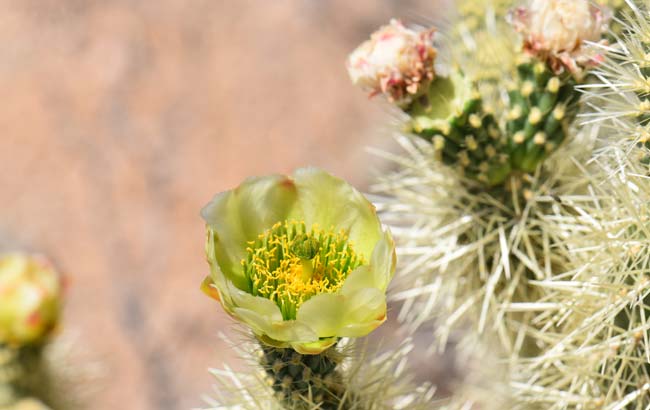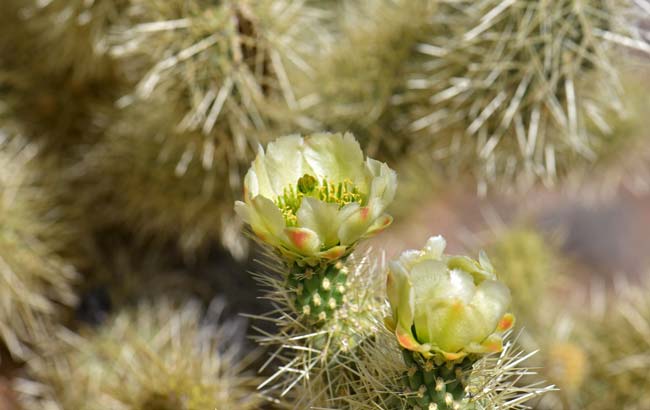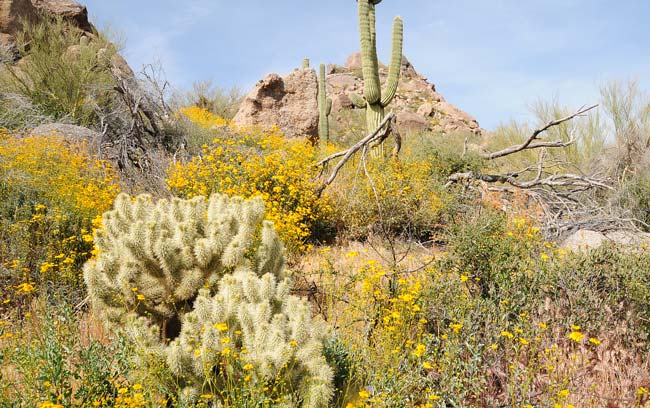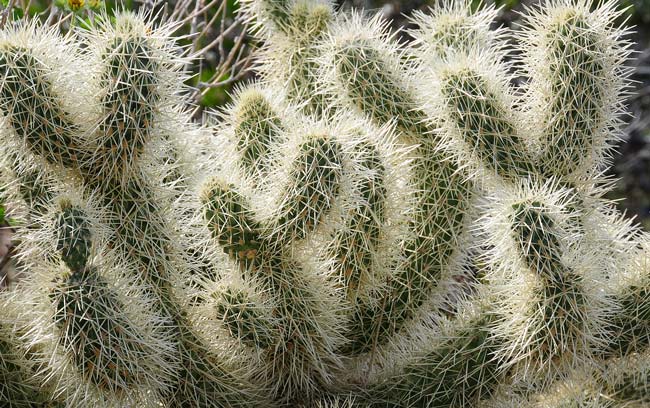Cylindropuntia bigelovii, Teddy Bear Cholla




Scientific Name: Cylindropuntia bigelovii
Common Name: Teddy Bear Cholla
Also Called: Jumping Cholla
Family: Cactaceae, Cactus Family
Synonyms: (Opuntia bigelovii)
Status: Native
Duration: Perennial
Size: Up to 5 feet or more.
Growth Form: Tree, Shrub, subshrub; densely branched, branches much shorter than the trunk.
Leaves: Leaves modified into spines or glochids and emerging from areoles.
Flower Color: Pale yellow, pale green, greenish yellow, sometimes red-tipped; flowers about 1½, fruit is deciduous; the upper tubercles are larger than the lower tubercles.
Flowering Season: March to June and again in September.
Elevation: Up to 3,000 feet.
Habitat Preferences: Sandy flats, gravelly to rocky washes, bajadas and hillsides; warm slopes in desert mountains; found in both Mojave and Sonoran Deserts.
Recorded Range: In the United States Teddy Bear Cholla is found in AZ, CA and NV. It is also native to Baja California and Mexico. In Arizona Teddy Bear Cholla is found in the central and western parts of the state.
North America & US County Distribution Map for Cylindropuntia bigelovii.
U.S. Weed Information: No information available.
Invasive/Noxious Weed Information: No information available.
Wetland Indicator: No information available.
Threatened/Endangered Information: Arizona, Opuntia bigelovii, Teddy Bear Cholla is salvage restricted; Nevada, Opuntia bigelovii, Teddy Bear Cholla is protected as a "Cactus, Yucca or Christmas tree".
In the Southwestern United States: Arizona has 12 species of genus, California has 10 species, Nevada has 5 species, New Mexico has 8 species, Texas has 6 species, Utah has 3 species. Hybrids excluded, all data is approximate and subject to taxonomic changes.
There is 1 variety in Cylindropuntia bigelovii:
Cylindropuntia bigelovii var. bigelovii; (AZ, CA, NV).
Comments: Teddy Bear Cholla is often used in desert landscapes in rock gardens, as a barrier and as a featured specimen. However care must be taken not to over-water as the roots are subject to rot. Well drained soils are a must.
The straw colored spiny joints of Teddy Bear Cholla easily detach from their parent plants and randomly fall to the ground by the dozens, easily stepped on by unsuspecting travelers. Spines on the joints are strongly barbed and when you are stuck by one you experience extreme deep pain and to make matters worse they are most difficult to remove as they grab on and adhere persistently.
The type specimen for Cylindropuntia bigelovii is from Mohave County, Arizona.
In Southwest Desert Flora also see: Buckhorn Cholla, Cylindropuntia acanthocarpa, Arizona Pencil Cholla, Cylindropuntia arbuscula, Jumping Cholla, Cylindropuntia fulgida, Gander's Buckhorn Cholla, Cylindropuntia ganderi, Klein's Pencil Cactus, Cylindropuntia kleiniae Christmas Cactus, Cylindropuntia leptocaulis Walkingstick Cactus, Cylindropuntia spinosior and Baja Pencil Cholla, Cylindropuntia tesajo.
Teddy Bear Cholla provided food and staples for southwestern American indigenous peoples.
See other ethno-botanical uses at Native American Ethnobotany, University of Michigan, Dearborn, Michigan.

